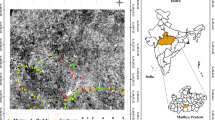Abstract
This present study was conducted to find out the usefulness of SWIR (Short Wave Infra Red) band data in AWiFS (Advanced Wide Field Sensor) sensor of Resourcesat 1, for the discrimination of different Rabi season crops (rabi rice, groundnut and vegetables) and other vegetations of the undivided Cuttack district of Orissa state. Four dates multi-spectral AWiFS data during the period from 10 December 2003 to 2 May 2004 were used. The analysis was carried out using various multivariate statistics and classification approaches. Principal Component Analysis (PCA) and separability measures were used for selection of best bands for crop discrimination. The analysis showed that, for discrimination of the crops in the study area, NIR was found to be the best band, followed by SWIR and Red. The results of the supervised MXL classification showed that inclusion of SWIR band increased the overall accuracy and kappa coefficient. The ‘Three Band Ratio’ index, which incorporated Red, NIR and SWIR bands, showed improved discrimination in the multi-date dataset classification, compared to other SWIR based indices.
Similar content being viewed by others
References
Alrichs JS and Bauer ME (1983) Relation of agronomic and multi-spectral reflectance characteristics of spring wheat canopies. Agronomy Journal 75: 987–993
Baret F, Guyot GT, Begue A, Maurial P and Podaire A (1988) Complementarity of middle-infrared with visible and near-infrared reflectance for monitoring wheat canopies. Rem Sens Environ 26: 213–225
Campbell JB (1989) Introduction to Remote Sensing. Taylor & Francis, London (2nd ed.) pp. 461
Carter GA (1994) Ratios of leaf reflectances in narrow wavebands as indicators of plant stress. Int J Rem Sens 15: 697–703
Ceccato P, Flassee S, Tarantola S, Jacquemoud S and Gregoire JM (2001) Detecting vegetation leaf water content using reflectance in the optical domain. Rem Sens Environ 77: 22–33
Chuvieco E, Riano D, Agnado I and Cocero D (2002) Estimation of fuel moisture content from multitemporal analysis of Landsat thematic mapper reflectance data: applications in fire danger assessment. Int J Rem Sens 23(11): 2145–2162
Czaplaski RL (1992) Misclassifiation bias in area estimation. Photogramm Engineer and Rem Sens, 58: 189–192
Dadhwal VK, Parihar JS, Medhavy TT, Rahul DS, Jarwal SD and Khera AP (1996) Comparative performance of thematic mapper middle-infrared bands in crop discrimination. Int J Rem Sens 17(9): 1727–1734
Dadhwal VK, Singh RP, Dutta S and Parihar JS (2002) Remote sensing based crop inventory: A review of Indian experience. Tropical Ecology 43(1): 107–122
Dean ME and Hoffer RM (1983) Feature selection methodologies using simulated thematic mapper data. Symp. Machine Processing of Remotely Sensed Data, LARS, Purdue University, West Lafayette, Ind. pp 347–356
Gao BC (1996) NDWI-A normalized difference water index for remote sensing of vegetation liquid water from space. Rem Sens Environ 58: 257–266
Hunt ER, Rock BN and Nobel PS (1987) Measurement of leaf relative water content by infra-red reflectance. Rem Sens Environ 22: 429–435
Knipling EB (1970) Physical and physiological basis for the reflectance of visible and near-infrared radiation. Rem Sens Environ 1: 155–159
Manjunath KR, Kundu N and Panigrahy S (1998) Evaluation of spectral bands and spatial resolution of LISS II and LISS III sensors onboard IRS satellites for crop identification. J Indian Soc Rem Sens 26(4): 197–208
Panigrahy S and Parihar JS (1992) Role of middle infrared bands of Landsat thematic mapper in determining the classification accuracy of rice. Int J Rem Sens 13(15): 2943–2949
Sharma SA, Bhatt HP and Ajai (1995) Oilseed crop discrimination: selection of optimum bands and role of middle infrared. ISPRS J Photogramm & Rem Sens 50(5): 25–30
Swain PH and Davis SM (1978) Remote Sensing: The Quantitative Approach. McGraw Hill, New York
Tucker CJ (1979) Red and photographic infrared linear combinations for monitoring vegetation. Rem Sens Environ 8: 127–150
Tucker CJ (1980) Remote Sensing of leaf water content in the near infrared. Rem Sens Environ 10: 23–32
Author information
Authors and Affiliations
Corresponding author
About this article
Cite this article
Panigrahy, R.K., Ray, S.S. & Panigrahy, S. Study on the utility of IRS-P6 AWiFS SWIR band for crop discrimination and classification. J Indian Soc Remote Sens 37, 325–333 (2009). https://doi.org/10.1007/s12524-009-0026-6
Received:
Accepted:
Published:
Issue Date:
DOI: https://doi.org/10.1007/s12524-009-0026-6




